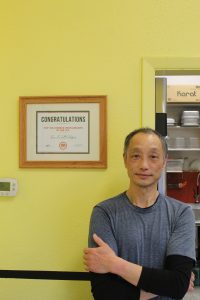- Beavers Digest
- Beavers Digest / Culture
- Beavers Digest / Culture / Community
- Beavers Digest / Entertainment
- Beavers Digest / Entertainment / Food & Drinks
Finding Food and Community
May 25, 2021
A study conducted by Mark Edwards, the sociology program director at Oregon State University’s Policy Analysis Laboratory, estimated that nearly one million Oregonians were experiencing food insecurity as of May 2020.
According to the United States Department of Agriculture, food insecurity consists of two types: low and very low food security.
Low food security is defined as “reports of reduced quality, variety or desirability of diet. Little or no indication of reduced food intake.” Very low food security is defined as a “report of multiple indications of disrupted eating patterns and reduced food intake.”
This high rate of food insecurity has been attributed to the loss of employment seen in Oregon and across the country.
“There has been such a catastrophic loss of jobs [and] livelihood resulting in food insecurity, housing insecurity [and] homelessness, and mental and physical health decline that it is hard to even estimate the cost to families,” said Annie Hoisington, a nutritional educator and associate professor for the College of Public Health and Human Sciences at OSU’s Portland campus.
Despite the increase of food insecurity since COVID-19 began, there are many services and resources provided by OSU and the state of Oregon for students to access.
Emily Faltesek, the food security programs coordinator for OSU’s Human Services and Resource Center confirmed that the numbers regarding food insecurity in Oregon in Edward’s report were accurate with what the HSRC has experienced.
“The research findings are very consistent with what we had at the HSRC,” Faltesek said. “Our numbers went up a ton.”
However, despite the stresses that COVID-19 has imposed on Oregon’s safety net services, the system has held up quite well.
“When the pandemic hit, there was tremendous cooperation and innovation in getting food to kids who were no longer able to go to school and receive reduced price lunches, or to quickly get emergency food to the many more people who were visiting food pantries, or to quickly get newly unemployed people signed up for [the Supplemental Nutrition Assistance Program],” Edwards said in an email.
Those who qualify for SNAP, previously known as food stamps, will receive an Oregon Trail card which is reloaded every month with funds for groceries.
The HSRC also provides sign-up support for SNAP and one-on-one assistance to students who have questions about food security services. Students can schedule an appointment with Miguel Arellano Sanchez, the HSRC basic needs navigator, to sign up for these services.
Furthermore, on Wednesdays from 10 a.m. to 3 p.m., the HSRC provides grocery support. This program offers shelf-stable items like rice, pasta, beans, corn and even Indomie instant noodles. Grocery items also include tofu, frozen meats, shelf-stable and refrigerated kinds of milk and milk alternatives.
The program is open to both the OSU and public community, and no ID is required. If you can’t make it during their official grocery support hours, you can make an appointment for another time.
In addition, the HSRC has the Healthy Beaver Bags program every Friday from noon to 2:30 p.m. This service is only available to OSU students. It offers fresh produce, ingredients and instructions for meals students can prepare at home.
“It’s like a recipe kit for trying out new recipes at home during COVID-19 that focuses on fresh, healthy ingredients,” said Faltesek.
The fresh ingredients and produce provided in the kits are sometimes sourced from local farms. According to Faltesek, past kits have included a French bread-making kit and a ramen-making kit which gives instructions on how to dress up your Ramen.
Although volunteering for the HRSC is not currently available for students and the greater community, you can still help food assistance efforts in many ways. This includes providing food donations, fostering conversations about food security and spreading the word about services like SNAP and the HSRC.
“Those connections between people and the information sharing inside a community is a really powerful thing students can do right now,” Faltesek said. “Even if there aren’t specific opportunities to stock shelves and offer service in that way.”
Edwards said these programs and services exist to serve during times of need and are part of a system that we have paid our money into.
“When those who do not use programs like SNAP communicate to others that they should avoid using these programs, they communicate that food insecurity is a shameful thing,” Edwards explained. “It’s not; it’s something that happens to people, not usually something they brought upon themselves.”






